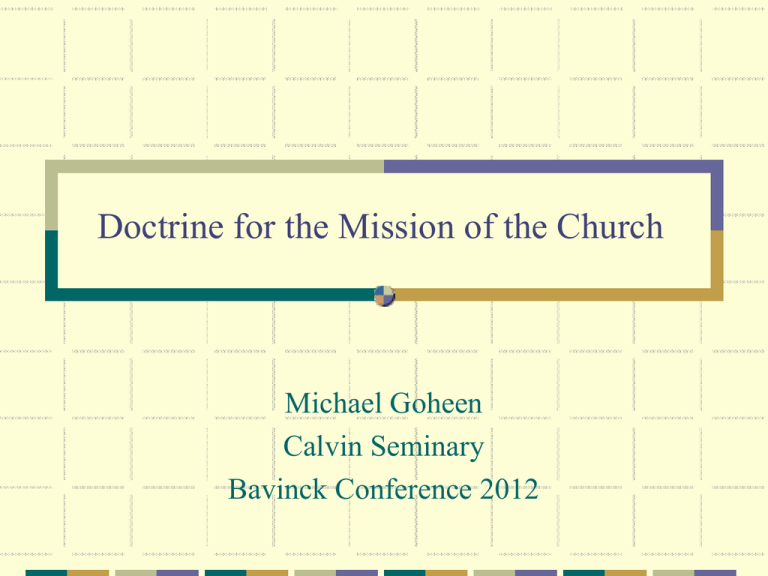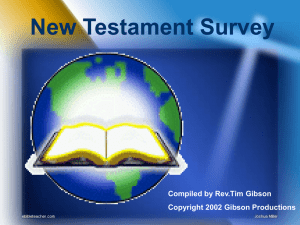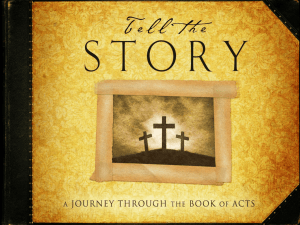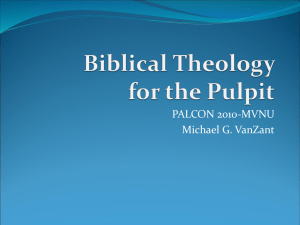Doctrine for Preaching Mission
advertisement

Doctrine for the Mission of the Church Michael Goheen Calvin Seminary Bavinck Conference 2012 Doctrine for Mission How can good doctrine nourish and equip the church for its mission? Answer in three parts: 1. Meaning of doctrine and mission 2. How can preaching doctrine nourish the church for its mission? 3. How can theological reflection on biblical doctrine equip the church for its mission? What is mission? Begin with God’s mission: God’s purpose to restore the whole creation, all nations, all of human life narrated in biblical story Chooses a people to participate: blessed to be a blessing or salvation in and through First about being: a distinctive people amidst the nations Then about words and activities What is doctrine? (Ridderbos) New Testament authority understood only with redemptive-historical categories Three: kerygma, marturia, didache Three vivid images Kerygma [proclamation]: realm of a herald proclaiming historical events as good news Marturia [witness]: realm of law court where a witness testifies to what they have seen or heard or experienced Didache [doctrine]: realm of Rabbinic thinking Doctrine Working out the significance and implications of a defining historical event for the life of the community Events give rise to a community and way of life Unfolding significance of those events for new situations and times What is doctrine? (NT Wright) ‘It was the story of Jesus (particularly his death and resurrection), told as the climax of the story of God and Israel and thus offering itself as both the true story of the world and the foundation and energizing force for the church’s mission.’ Three aspects of doctrine Story of Jesus (life, death, resurrection) As it fulfils the Old Testament story As it is brought to bear on the church’s life to equip it for mission Relating doctrine to mission Scriptures are a record of God’s mission in and through his people Scriptures are a tool to effectively shape God’s people for their missional role Scriptural authority and mission Biblical authority: ‘sub-branch . . . of the mission of the church’ Q: ‘What role does Scripture play within God’s accomplishment of this goal?’ A: ‘God’s self-revelation is always to be understood within the category of God’s mission to the world, God’s saving sovereignty let loose through Jesus and the Spirit and aimed at the healing and renewal of the creation.’ Unfolds in four stages The Old Testament Scriptures were written to equip God’s people for their missional calling to be a distinctive people Jesus fulfils the purpose of the Old Testament: He accomplishes what the OT had been trying to do—bring salvation to God’s people and through them to the world (Rom 8.3-4) Unfolds in four stages Apostolic preaching and doctrine make Christ present in transforming power to shape God’s people for their mission New Testament authors committed apostolic preaching and doctrine to written form Continues In to make Christ present power To transform God’s people for mission How can preaching doctrine nourish the mission of the church? Acts 2.42-47: devotion, life, drawing power Apostolic doctrine: one of four channels by which Spirit nourishes new life Making Christ present Next step in Wright’s exposition: Christ is present in power to renew people for mission a) bodily; b) apostolic word; c) NT; d) preaching ‘The business of the sermon is to bring the hearers face to face with Jesus Christ as he really is.’ (Newbigin) “For Holy Scripture is the garment which our Lord Christ has put on and in which He lets Himself be seen and found.” (Luther) “This, then, is the true knowledge of Christ, if we receive him as he is offered by the Father: namely, clothed with his gospel.” (Calvin) Preaching doctrine . . . Brings us face to face with Jesus Christ As he really is Unfolds implications of his Lordship over whole of life ‘That salvation is universal in nature; it encompasses man in his full existence and in all of his relationships and affairs . . .The redemption described in the New Testament . . . views all of that . . . from the great theocentric viewpoint of God’s revelation in Jesus Christ.’ (Ridderbos) Preaching doctrine . . . Brings us face to face with Jesus Christ Will encounter other idolatrous ways of life, challenge other lords of reigning cultural story Tells a different story than cultural story Dismantles dominant idols and offers an alternative imagination rooted in a different story Must be relevant and address idols of day: ‘If you preach the gospel in all aspects with the exception of the issues which deal specifically with your time you are not preaching the gospel at all.’ (Luther) Preaching doctrine . . . Brings us face to face with Jesus Christ Will encounter other idolatrous ways of life, challenge other lords of reigning cultural story Will orient people of God to the world Salvation for but also through the church Opposes ‘self-centred religiosity’ (Thielicke) and ‘soteriological self-centredness (Berkouwer) How can theological reflection equip the church for its mission? Focus on one area: theology must be contextual addressing issues and idols of a particular context Reacting against universalising tendency of theology in wake of Enlightenment Our creedal formulations structured to respond to the 16th century cultural setting and its problems, lose their historical character as contextual confessions of faith and become cultural universals, having comprehensive validity in all times and settings. . . . The Reformation is completed and we in the West wait for the churches of the Third World to accept as their statements of faith those shaped by a Western church three centuries ago in a corpus Christianum . . . We have diminished their historical, cultural character. The creed as a missionary document framed in the uniqueness of an historical moment has too often been remythologized by white paternalism into a universal Essence for all times. (Conn) The responsibility of the church [is] to declare to each generation what is the faith, to expose and combat errors destructive of the faith, to expel from her body doctrines which pervert the faith, and to lead her members into a full and vivid apprehension of the faith. . . . This is always a fresh task in every generation, for thought is never still. The words in which the Church states its message in one generation have changed their meaning by the time the next has grown up. No verbal statement can be produced which relieves the Church of the responsibility continually to re-think and re-state its message. No appeal [to creeds and confessions] can alter the fact that the Church has to state in every new generation how it interprets the historic faith, and how it relates it to the new thought and experience of its time. . . . Nothing can remove from the Church the responsibility for stating now what is the faith. It belongs to the essence of a living Church that it should be able and willing to do so. (Newbigin) Contextual theology Positive task: explicate the faith in the present to enable the church to take hold of its confession in vital way Negative task: protect the faith from distortion of idolatrous thought New Testament as a model? Martin Kähler: ‘the oldest mission became the mother of theology’ (1908) ‘The congregations founded by the first missionaries had, as their purpose, the continuation of the witness that had led to their founding. The writings that became the canonic New Testament all functioned basically as instruments for the continuing formation of these communities for the faithful fulfillment of their missional vocation. The first theological work of the church is found in the epistles and gospels that focus on the concrete situations of missional congregations and their witness—here we see the earliest instance of mission functioning as the mother of theology.’ (Guder) Three attendant dangers of contextual theology Scriptural authority may be eclipsed History and tradition of the church may be ignored The spectre of relativism looms Addressing concerns The Bible is the starting point and final authority for all contextual theologies ‘True Christian theology is a form of rational discourse . . . which accepts the primacy of the Biblical story . . .’ (Newbigin) Addressing concerns The Bible is the starting point and final authority for all contextual theologies All contextual theologies must engage in dialogue with other theologies in other historical situations, in other cultural situations, and in other confessional traditions Threefold ecumenical dialogue Historical: creeds and confessions; our own tradition; broader Christian tradition Confessional: other confessional traditions Cultural: African, Asian, Latin American Need for ecumenical dialogue Danger of contextual theology being reductionist or accommodated to cultural idolatry Need for dialogue that is both mutually corrective and mutually enriching ‘What God has given us [in Scripture] is inexhaustible, but we are only little people, still on the way toward fully understanding everything, while the gospel needs restating in ever new situations. There are bound to be many theological articulations of the faith, all of them pointing to the same thing and by their multiplicity relativizing and complementing each other.’ (H. Berkhof) The reference to mutual correction is the crucial one. All reading of the Bible and all our Christian discipleship are necessarily shaped by the cultures which have formed us. . . . the only way in which the gospel can challenge our culturally conditioned interpretation of it is through the witness of those who read the Bible with minds shaped by other cultures. We have to listen to others. The mutual correction is sometimes unwelcome, but it is necessary and it is fruitful. (Newbigin) Conclusion Theology that is 1) rooted in the gospel and the biblical story; 2) addressed to current needs of the church in mission today; 3) corrected and enriched by brothers and sisters from other epochs of history, other confessional traditions, and other cultural contexts can be a theology that equips church for its mission.











